airbag FIAT FIORINO 2019 Owner handbook (in English)
[x] Cancel search | Manufacturer: FIAT, Model Year: 2019, Model line: FIORINO, Model: FIAT FIORINO 2019Pages: 220, PDF Size: 6.22 MB
Page 10 of 220
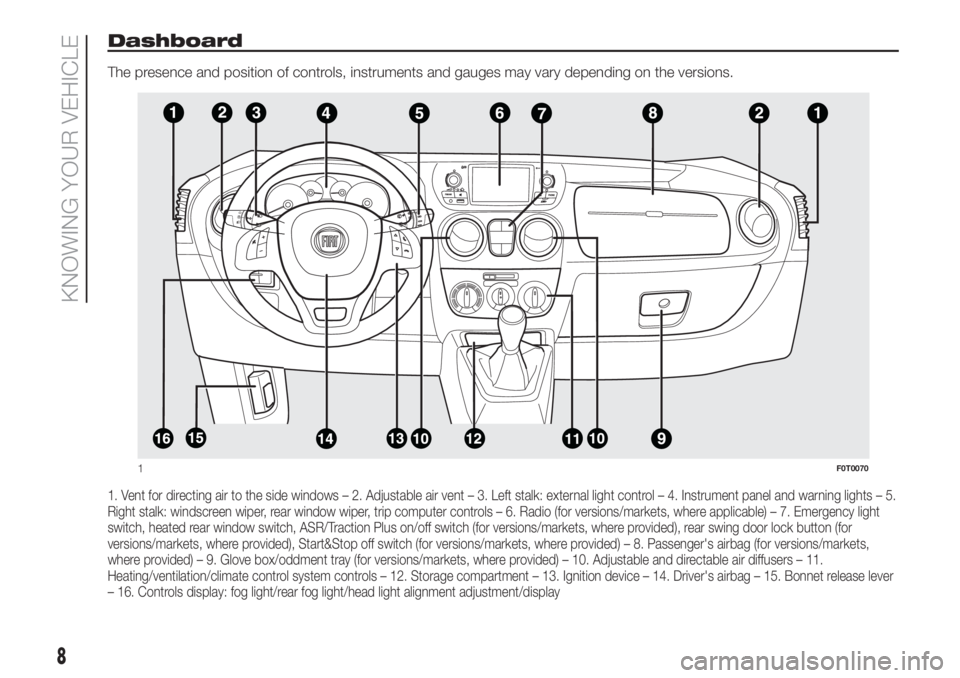
Dashboard
The presence and position of controls, instruments and gauges may vary depending on the versions.
1. Vent for directing air to the side windows – 2. Adjustable air vent – 3. Left stalk: external light control – 4. Instrument panel and warning lights – 5.
Right stalk: windscreen wiper, rear window wiper, trip computer controls – 6. Radio (for versions/markets, where applicable) – 7. Emergency light
switch, heated rear window switch, ASR/Traction Plus on/off switch (for versions/markets, where provided), rear swing door lock button (for
versions/markets, where provided), Start&Stop off switch (for versions/markets, where provided) – 8. Passenger's airbag (for versions/markets,
where provided) – 9. Glove box/oddment tray (for versions/markets, where provided) – 10. Adjustable and directable air diffusers – 11.
Heating/ventilation/climate control system controls – 12. Storage compartment – 13. Ignition device – 14. Driver's airbag – 15. Bonnet release lever
– 16. Controls display: fog light/rear fog light/head light alignment adjustment/display
1F0T0070
8
KNOWING YOUR VEHICLE
Page 48 of 220
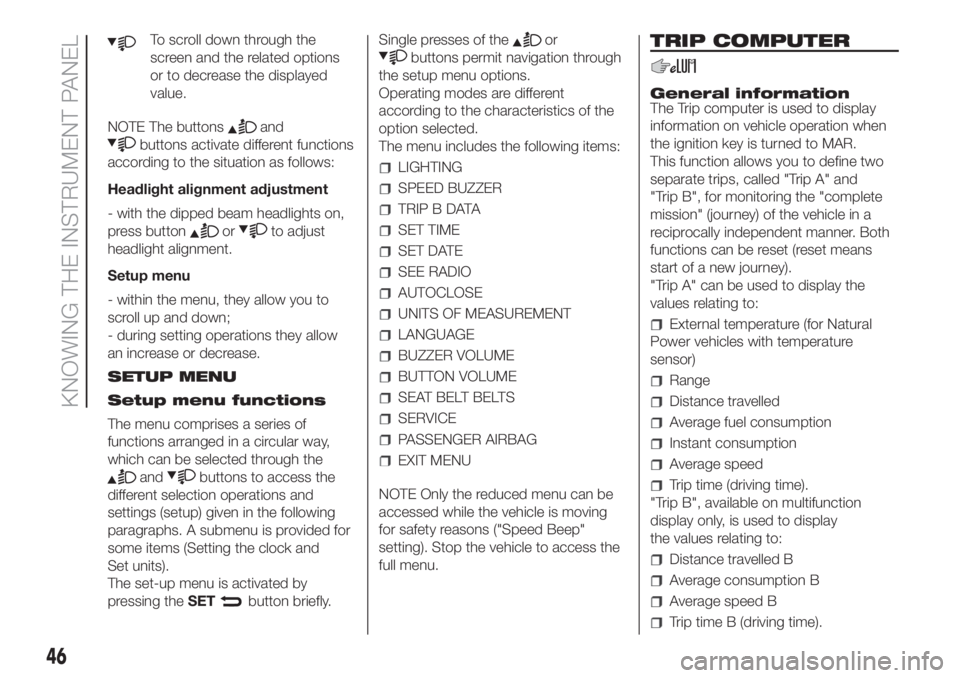
To scroll down through the
screen and the related options
or to decrease the displayed
value.
NOTE The buttons
and
buttons activate different functions
according to the situation as follows:
Headlight alignment adjustment
- with the dipped beam headlights on,
press button
orto adjust
headlight alignment.
Setup menu
- within the menu, they allow you to
scroll up and down;
- during setting operations they allow
an increase or decrease.
SETUP MENU
Setup menu functions
The menu comprises a series of
functions arranged in a circular way,
which can be selected through the
andbuttons to access the
different selection operations and
settings (setup) given in the following
paragraphs. A submenu is provided for
some items (Setting the clock and
Set units).
The set-up menu is activated by
pressing theSET
button briefly.Single presses of the
or
buttons permit navigation through
the setup menu options.
Operating modes are different
according to the characteristics of the
option selected.
The menu includes the following items:
LIGHTING
SPEED BUZZER
TRIP B DATA
SET TIME
SET DATE
SEE RADIO
AUTOCLOSE
UNITS OF MEASUREMENT
LANGUAGE
BUZZER VOLUME
BUTTON VOLUME
SEAT BELT BELTS
SERVICE
PASSENGER AIRBAG
EXIT MENU
NOTE Only the reduced menu can be
accessed while the vehicle is moving
for safety reasons ("Speed Beep"
setting). Stop the vehicle to access the
full menu.
TRIP COMPUTER
General information
The Trip computer is used to display
information on vehicle operation when
the ignition key is turned to MAR.
This function allows you to define two
separate trips, called "Trip A" and
"Trip B", for monitoring the "complete
mission" (journey) of the vehicle in a
reciprocally independent manner. Both
functions can be reset (reset means
start of a new journey).
"Trip A" can be used to display the
values relating to:
External temperature (for Natural
Power vehicles with temperature
sensor)
Range
Distance travelled
Average fuel consumption
Instant consumption
Average speed
Trip time (driving time).
"Trip B", available on multifunction
display only, is used to display
the values relating to:
Distance travelled B
Average consumption B
Average speed B
Trip time B (driving time).
46
KNOWING THE INSTRUMENT PANEL
Page 51 of 220

What it means What to do
red
amber
amberEBD FAILURE
The simultaneous switching on of the
(red),
(amber) and(amber) warning lights with the
engine on indicates either an anomaly of the EBD
system or that the system is not available. In this case,
the rear wheels may suddenly lock and the vehicle
may swerve when braking sharply.
On some versions the display shows the dedicated
message.Drive very carefully to the nearest Fiat Dealership to
have the system inspected immediately.
redAIR BAG FAILURE
The warning light switches on when the ignition key is
turned to MAR, but it should switch off after a few
seconds.
The warning light stays on constantly if there is a failure
in the airbag system.
On some versions the display shows the dedicated
message.
35) 36)
49
Page 56 of 220

WARNING
34)If thewarning light turns on while driving (on certain versions together with the message on the display) stop the car immediately and
contact a Fiat Dealership.
35)The warning light
may not light up when the key is turned to MAR or stay on while travelling to indicate a retaining system fault. In this
case, the airbags or the pretensioners may not be activated in the case of an accident or (in a lesser number of cases) they may be activated
incorrectly. Before continuing, contact a Fiat Dealership to have the system checked immediately.
36)A failure of the
warning light is indicated by thewarning light flashing or, depending on the version, by theicon turning on
continuously on the display. In this case, thewarning light may not indicate a possible problem with the airbag restraint system. Before
continuing, contact a Fiat Dealership to have the system checked immediately.
37)If the
warning light switches on when travelling (on certain versions together with the message on the display), stop the engine
immediately and contact a Fiat Dealership.
WARNING
9)If the warning light switches on, the degraded engine oil must be changed as soon as possible, and never more than 500 km from the first
time that the warning light switches on. Failure to observe the above may result in severe damage to the engine and invalidate the warranty.
The activation of this warning light is not related to the amount of oil in the engine. Therefore, never top up with oil when the warning light
starts flashing.
54
KNOWING THE INSTRUMENT PANEL
Page 63 of 220

What it means What to do
amberFuel cut-off inertia switch tripped
The warning light switches on when the fuel cut-off
inertia switch is tripped. The display shows the
dedicated message.
Parking sensor failure
(for versions/markets, where provided)
See parking sensor warning light section.In this case, the
warning light may not indicate a
possible problem with the airbag restraint system.
Before continuing, contact a Fiat Dealership to have
the system checked immediately.
Airbag failure warning light
Thewarning light turns on and flashes to indicate a
failure of the
warning light. In this case, the
warning light may not indicate a possible problem
with the airbag restraint system.Before continuing, contact a Fiat Dealership to have
the system checked immediately.
Start&Stop system failure
(for versions/markets, where provided)
The warning light comes on alternatively to the
warning light
when a Start&Stop system fault is
detected.In this case, contact the Fiat Service Network as soon
as possible.
61
Page 72 of 220
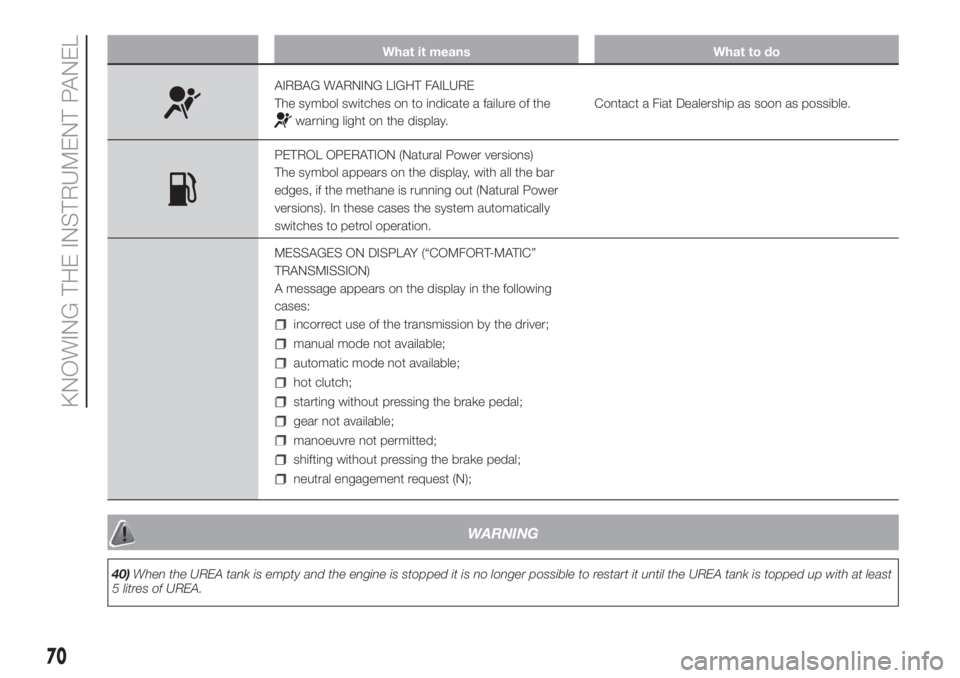
What it means What to do
AIRBAG WARNING LIGHT FAILURE
The symbol switches on to indicate a failure of the
warning light on the display.Contact a Fiat Dealership as soon as possible.
PETROL OPERATION (Natural Power versions)
The symbol appears on the display, with all the bar
edges, if the methane is running out (Natural Power
versions). In these cases the system automatically
switches to petrol operation.
MESSAGES ON DISPLAY (“COMFORT-MATIC”
TRANSMISSION)
A message appears on the display in the following
cases:
incorrect use of the transmission by the driver;
manual mode not available;
automatic mode not available;
hot clutch;
starting without pressing the brake pedal;
gear not available;
manoeuvre not permitted;
shifting without pressing the brake pedal;
neutral engagement request (N);
WARNING
40)When the UREA tank is empty and the engine is stopped it is no longer possible to restart it until the UREA tank is topped up with at least
5 litres of UREA.
70
KNOWING THE INSTRUMENT PANEL
Page 73 of 220
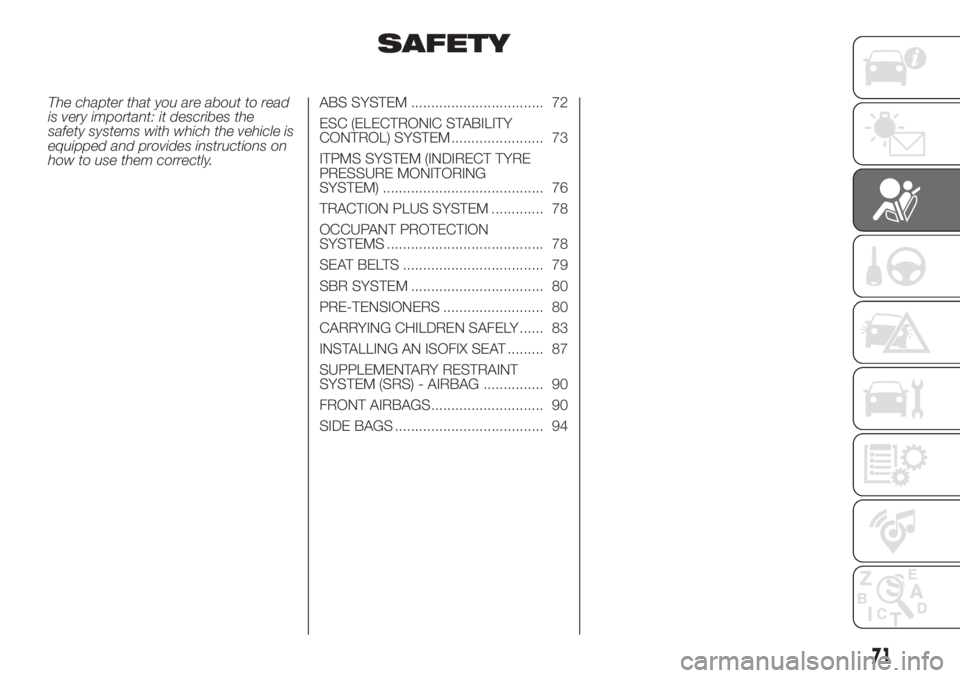
SAFETY
The chapter that you are about to read
is very important: it describes the
safety systems with which the vehicle is
equipped and provides instructions on
how to use them correctly.ABS SYSTEM ................................. 72
ESC (ELECTRONIC STABILITY
CONTROL) SYSTEM ....................... 73
ITPMS SYSTEM (INDIRECT TYRE
PRESSURE MONITORING
SYSTEM) ........................................ 76
TRACTION PLUS SYSTEM ............. 78
OCCUPANT PROTECTION
SYSTEMS ....................................... 78
SEAT BELTS ................................... 79
SBR SYSTEM ................................. 80
PRE-TENSIONERS ......................... 80
CARRYING CHILDREN SAFELY ...... 83
INSTALLING AN ISOFIX SEAT ......... 87
SUPPLEMENTARY RESTRAINT
SYSTEM (SRS) - AIRBAG ............... 90
FRONT AIRBAGS............................ 90
SIDE BAGS ..................................... 94
71
Page 80 of 220
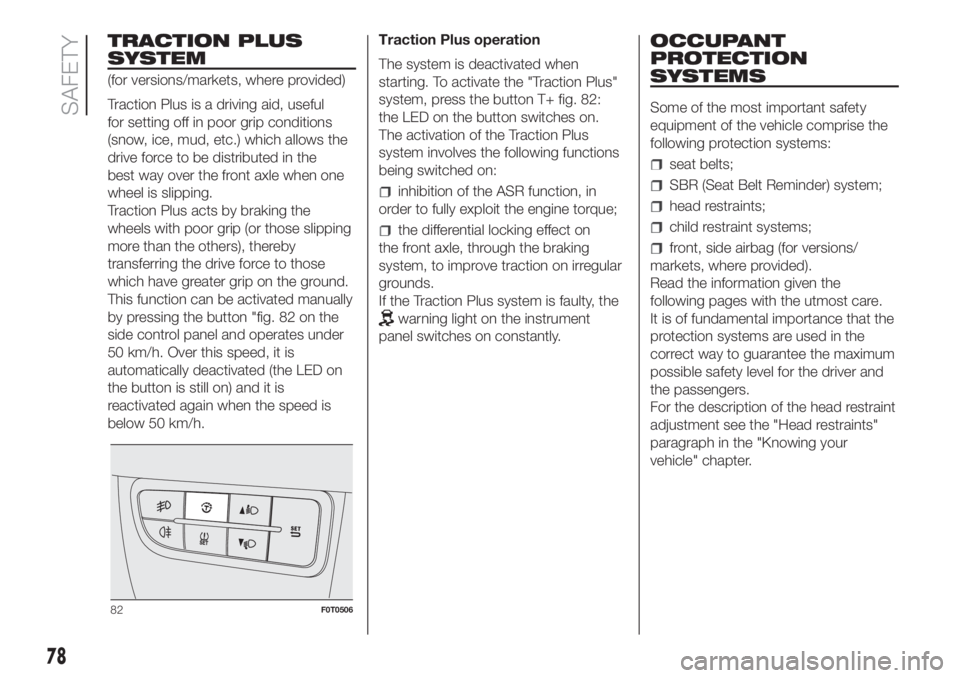
TRACTION PLUS
SYSTEM
(for versions/markets, where provided)
Traction Plus is a driving aid, useful
for setting off in poor grip conditions
(snow, ice, mud, etc.) which allows the
drive force to be distributed in the
best way over the front axle when one
wheel is slipping.
Traction Plus acts by braking the
wheels with poor grip (or those slipping
more than the others), thereby
transferring the drive force to those
which have greater grip on the ground.
This function can be activated manually
by pressing the button "fig. 82 on the
side control panel and operates under
50 km/h. Over this speed, it is
automatically deactivated (the LED on
the button is still on) and it is
reactivated again when the speed is
below 50 km/h.Traction Plus operation
The system is deactivated when
starting. To activate the "Traction Plus"
system, press the button T+ fig. 82:
the LED on the button switches on.
The activation of the Traction Plus
system involves the following functions
being switched on:
inhibition of the ASR function, in
order to fully exploit the engine torque;
the differential locking effect on
the front axle, through the braking
system, to improve traction on irregular
grounds.
If the Traction Plus system is faulty, the
warning light on the instrument
panel switches on constantly.
OCCUPANT
PROTECTION
SYSTEMS
Some of the most important safety
equipment of the vehicle comprise the
following protection systems:
seat belts;
SBR (Seat Belt Reminder) system;
head restraints;
child restraint systems;
front, side airbag (for versions/
markets, where provided).
Read the information given the
following pages with the utmost care.
It is of fundamental importance that the
protection systems are used in the
correct way to guarantee the maximum
possible safety level for the driver and
the passengers.
For the description of the head restraint
adjustment see the "Head restraints"
paragraph in the "Knowing your
vehicle" chapter.
82F0T0506
78
SAFETY
Page 87 of 220

SUITABILITY OF PASSENGER SEATS FOR THE USE OF CHILD RESTRAINT
SYSTEMS
The vehicles designed to carry people (homologation M1) comply with the new European Directive 2000/3/EC which governs
the arrangement possibilities for child restraint systems on the seats of the vehicle as shown in the following table:
Group Weight range Front passenger Rear passenger
Airbag enabled Airbag deactivated
Group 0, 0+ up to 13 kgXUU
Group 1 9 - 18 kgXUU
Group 2 15 - 25 kgUUU
Group 3 22–36 kgUUU
X Seat not suitable for children in this weight category.
U suitable for child restraint systems in the "Universal" category, according to European Standard ECE-R44 for the specified "Groups".
WARNING
73)SERIOUS DANGER: When an active passenger airbag is fitted, DO NOT install rear facing child restraint systems on the front seat.
Deployment of the airbag in an accident could cause fatal injuries to the child regardless of the severity of the impact. It is advisable to always
carry children in a child restraint system on the rear seat, which is the most protected position in the event of a collision.
74)Should it be necessary to carry a child on the passenger side front seat in a rearward-facing child restraint system, the passenger side
front airbag and side bag (for versions/markets, where provided) must be deactivated through the Setup menu. Deactivation should be
verified by checking whether the
warning light is switched on in the central dashboard. Move the passenger's seat as far back as possible
to avoid contact between the child seat and the dashboard.
75)On the sun visor there is a label with suitable symbols reminding the user that it is compulsory to deactivate the airbag if a rearward facing
child restraint system is fitted. Always comply with the instructions on the passenger side sun visor (see the "Supplementary Restraint
System (SRS) - Airbag" paragraph).
76)Do not move the front or rear seat if a child is seated on it or on the dedicated child restraint system.
77)Incorrect fitting of the child restraint system may result in an inefficient protection system. In the event of an accident the child restraint
system may become loose and the child may be injured, even fatally. When fitting a restraint system for newborns or children, strictly comply
with the instructions provided by the Manufacturer.
85
Page 91 of 220
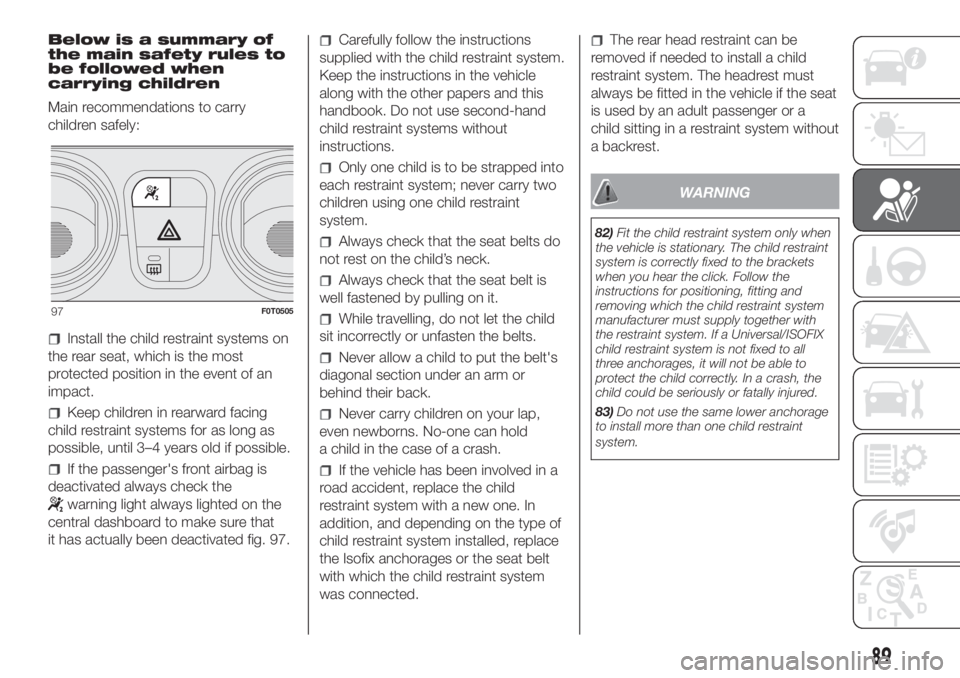
Below is a summary of
the main safety rules to
be followed when
carrying children
Main recommendations to carry
children safely:
Install the child restraint systems on
the rear seat, which is the most
protected position in the event of an
impact.
Keep children in rearward facing
child restraint systems for as long as
possible, until 3–4 years old if possible.
If the passenger's front airbag is
deactivated always check the
warning light always lighted on the
central dashboard to make sure that
it has actually been deactivated fig. 97.
Carefully follow the instructions
supplied with the child restraint system.
Keep the instructions in the vehicle
along with the other papers and this
handbook. Do not use second-hand
child restraint systems without
instructions.
Only one child is to be strapped into
each restraint system; never carry two
children using one child restraint
system.
Always check that the seat belts do
not rest on the child’s neck.
Always check that the seat belt is
well fastened by pulling on it.
While travelling, do not let the child
sit incorrectly or unfasten the belts.
Never allow a child to put the belt's
diagonal section under an arm or
behind their back.
Never carry children on your lap,
even newborns. No-one can hold
a child in the case of a crash.
If the vehicle has been involved in a
road accident, replace the child
restraint system with a new one. In
addition, and depending on the type of
child restraint system installed, replace
the Isofix anchorages or the seat belt
with which the child restraint system
was connected.
The rear head restraint can be
removed if needed to install a child
restraint system. The headrest must
always be fitted in the vehicle if the seat
is used by an adult passenger or a
child sitting in a restraint system without
a backrest.
WARNING
82)Fit the child restraint system only when
the vehicle is stationary. The child restraint
system is correctly fixed to the brackets
when you hear the click. Follow the
instructions for positioning, fitting and
removing which the child restraint system
manufacturer must supply together with
the restraint system. If a Universal/ISOFIX
child restraint system is not fixed to all
three anchorages, it will not be able to
protect the child correctly. In a crash, the
child could be seriously or fatally injured.
83)Do not use the same lower anchorage
to install more than one child restraint
system.
97F0T0505
89